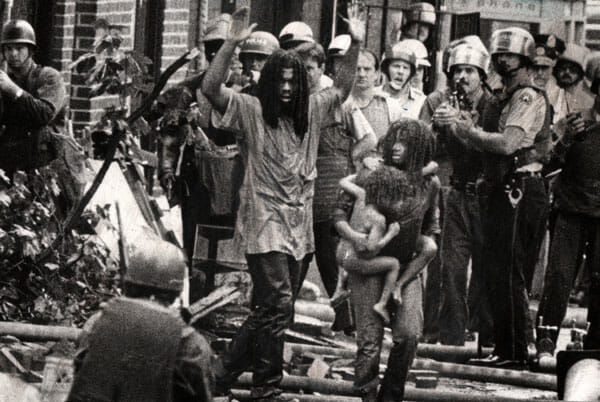Let the Fire Burn

Jason Osder’s documentary Let the Fire Burn sheds light on an incident that’s long-forgotten by many, except for those who lived in the Philadelphia area in 1980s (full disclosure, this reviewer did). On May 13, 1985, the city essentially committed an act of self-immolation—offering the lives of nearly a dozen members of a radical group and the livelihoods of hundreds of its residents as sacrifice.
After a long-simmering and sometimes violent feud between the city of Philadelphia and the Black Power group MOVE, Mayor Wilson Goode, the city’s first black mayor, ordered the police to extricate 13 MOVE members barricading themselves in their row-house commune. After failing to collapse a bunker on the roof with water cannons, and expending 10,000 rounds of ammunition (the Philadelphia police actually ran out of bullets and asked the state police to deliver additional munitions)—the decision was made to drop an explosive device on the structure.
With local TV cameras capturing the action, residents watched as a fire began to engulf the row-home. Only two MOVE members were able to escape the fire; the remaining 11 people, including five children, died. As if that weren’t tragic enough, a total of 61 homes on and around Osage Avenue, a primarily working class black neighborhood, also burned to the ground. Only later was it discovered that the authorities made the decision to “let the fire burn.” By the time the fire department started battling the blaze, it was too large and fast to control, destroying much of the community.
First-time filmmaker Osder, with masterful editing by Nels Bangerter, has crafted a captivating and taut documentary about the MOVE organization and its long and often antagonistic relationship with the city. Even more impressively, the film is composed entirely from found footage: news clips, police cameras, MOVE videos, post-fire hearings and the video deposition of the youngest survivor, Birdie Africa (aka Michael Moses Ward). By excluding more recent interviews, Osder tries to ensure that testimonials and memories aren’t distorted by the passage of time. Let the Fire Burn remains decidedly of the era, but the themes of racism, police brutality, First Amendment rights and finger-pointing politicians still resonate today.